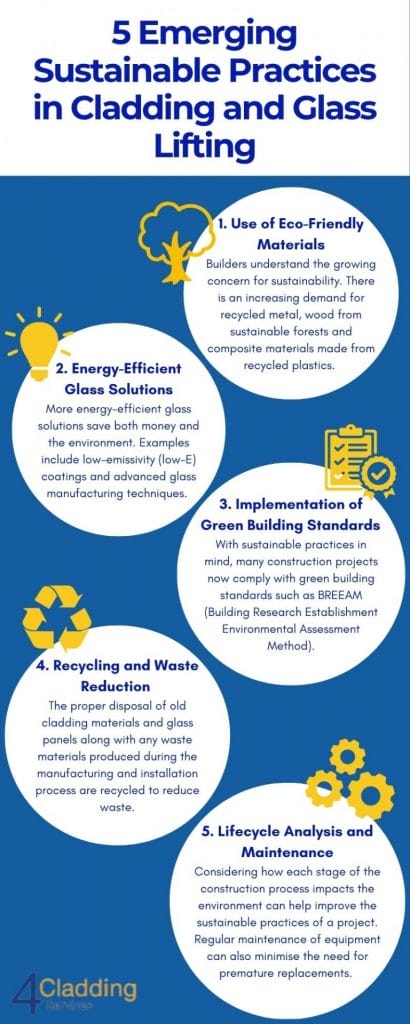In the ever-evolving vacuum lifting industry, staying ahead of the curve is essential, and that’s exactly what we aim to do here. From advancements in sustainable materials to the integration of smart technologies, we’ll delve into the trends shaping the future of construction. Join us as we analyse how these developments are influencing project execution, equipment innovation, and safety standards while also offering predictions for what lies ahead.
Technological Advancements Driving the Industry Forward
In the construction industry, technological advancements continually shape and redefine industry practices, driving innovation and progress. When it comes to cladding and glass lifting, it becomes evident that technological breakthroughs play a pivotal role in propelling the industry forward.
Construction Technology Trends
One such emerging trend is the infusion of the Internet of Things (IoT) and data analytics into project management practices. This underscores a shift towards smarter, more connected construction sites.
Picture this: a construction site where everything is connected and constantly sharing information. That’s the idea behind the Internet of Things (IoT) and data analytics in construction. Basically, it means that all the different machines and equipment on a construction site can communicate with each other through the Internet. They can share data about things like how much weight they’re lifting or how fast they’re working.
This data can then be analysed to ensure everything runs smoothly and safely. For example, if a machine starts acting strange, it can send an alert to the workers to investigate before it becomes a safety hazard.
Glass Lifting Innovations
The glass lifting industry has seen remarkable advancements in recent years, particularly with the introduction of innovative suction cup technology. This technology has revolutionised the way glass panels are handled, enabling precise and effortless lifting even for heavy-duty weights. Glass lifters equipped with electric hoists can now operate at various heights while maintaining stability, making them versatile solutions for construction projects.
Additionally, integrating hydraulic lifting arms ensures efficient and consistent lifting results, further enhancing productivity on-site. With a wide range of safe working loads available, these innovations offer flexibility to meet the diverse requirements of different projects. Glass lifting innovations provide strength and reliability and contribute to improved safety standards and streamlined operations in the construction industry.
5 Emerging Sustainable Practices in Cladding and Glass Lifting
There has been a growing emphasis on sustainability within the construction industry in recent years, and the cladding and glass lifting sectors are no exception. Sustainable practices in these areas focus on minimising environmental impact, reducing energy consumption, and promoting long-term durability. Let’s take a closer look at some of the sustainable practices being adopted:
1. Use of Eco-Friendly Materials:
One key aspect of sustainability in cladding involves the use of eco-friendly materials. Builders are increasingly turning to materials such as recycled metal, wood from sustainable forests, and composite materials made from recycled plastics. These materials reduce the demand for virgin resources and minimise waste and pollution.
2. Energy-Efficient Glass Solutions:
Sustainable glass lifting practices often revolve around the use of energy-efficient glass solutions. This includes low-emissivity (low-E) coatings, which help reduce heat transfer and improve insulation, lowering heating and cooling costs in buildings. Additionally, advances in glass manufacturing techniques have led to the development of thinner yet stronger glass panels, further enhancing energy efficiency.
3. Implementation of Green Building Standards:
Many construction projects now adhere to green building standards such as BREEAM (Building Research Establishment Environmental Assessment Method). These standards incorporate sustainable practices throughout the building process, including selecting cladding materials and glass lifting methods that minimise environmental impact.
4. Recycling and Waste Reduction:
Sustainable practices also involve recycling and minimising waste generated during construction and demolition processes. This includes proper disposal of old cladding materials and glass panels, as well as recycling any waste materials produced during manufacturing and installation.
5. Lifecycle Analysis and Maintenance:
Another important aspect of sustainable practices is considering the entire cladding and glass lifting systems lifecycle. This includes conducting lifecycle assessments to evaluate the environmental impact of materials and processes at every stage, from extraction and manufacturing to installation and eventual disposal. Additionally, regular maintenance and upkeep of cladding and glass lifting equipment can prolong their lifespan, reducing the need for premature replacements and further minimising environmental impact.


Predictions for the Future of Cladding and Glass Lifting
As we look ahead to the future of the construction industry, particularly in the realms of cladding and glass lifting, several trends and developments are poised to shape the landscape in the coming years. Here are some predictions for what the future holds:
Integration of Smart Technologies:
The incorporation of smart technologies such as IoT (Internet of Things) and AI (Artificial Intelligence) is set to revolutionise cladding and glass lifting practices. Smart cladding systems equipped with sensors will provide real-time data on building performance, allowing for proactive maintenance and energy optimisation. Similarly, intelligent glass lifting equipment will leverage AI algorithms to enhance precision and efficiency, streamlining operations on construction sites.
Safety and Ergonomics:
With an ongoing emphasis on worker safety and ergonomics, we anticipate the development of advanced safety features in both cladding and glass lifting equipment. This includes the integration of automated safety protocols and ergonomic design enhancements to minimise the risk of accidents and injuries on construction sites.
Learn More About the Future of Vacuum Lifters
The future of vacuum lifting holds immense promise and potential. From sustainable practices to technological advancements, the construction landscape is evolving rapidly, and staying informed is key to staying ahead. If you want to learn more about cladding and glass lifting, get in touch with our expert team for further advice.
You can also explore our range of glass lifters and more vacuum lifters available at 4Cladding.
Frequently Asked Questions
What are the benefits of using glass vacuum lifters for lifting operations?
Glass vacuum lifters offer several benefits, including increased efficiency, enhanced safety, and reduced risk of damage to glass panels. By utilising vacuum suction technology, these lifters provide a secure grip on glass surfaces, allowing for precise and controlled lifting even with heavy loads. Additionally, they help to minimise manual handling and labour requirements, resulting in improved productivity on construction sites.
How can sustainable cladding solutions contribute to environmental conservation?
Sustainable cladding solutions play a vital role in reducing the environmental impact of construction projects. By utilising eco-friendly materials such as recycled metal or wood from sustainable sources, builders can minimise the depletion of natural resources and reduce carbon emissions. Additionally, energy-efficient cladding systems help to improve building insulation, reducing heating and cooling costs and overall energy consumption.
How can I determine the right glass vacuum lifter for my specific project needs?
Choosing the right glass vacuum lifter depends on various factors, including the size and weight of the glass panels, the height of the lifting operation, and the available space on the construction site. It’s essential to consult with a qualified supplier or manufacturer who can assess your project requirements and recommend the most suitable lifter model and configuration. You should also consider factors such as load capacity, manoeuvrability, and safety features when selecting a glass vacuum lifter for your project.
Related Articles
How to Choose the Right Glass Vacuum Lifter for Your Project